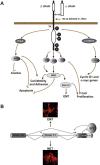Alternative splicing and tumor progression
- PMID: 19516963
- PMCID: PMC2694562
- DOI: 10.2174/138920208786847971
Alternative splicing and tumor progression
Abstract
Alternative splicing is a key molecular mechanism for increasing the functional diversity of the eukaryotic proteomes. A large body of experimental data implicates aberrant splicing in various human diseases, including cancer. Both mutations in cis-acting splicing elements and alterations in the expression and/or activity of splicing regulatory factors drastically affect the splicing profile of many cancer-associated genes. In addition, the splicing profile of several cancer-associated genes is altered in particular types of cancer arguing for a direct role of specific splicing isoforms in tumor progression. Deciphering the mechanisms underlying aberrant splicing in cancer may prove crucial to understand how splicing machinery is controlled and integrated with other cellular processes, in particular transcription and signaling pathways. Moreover, the characterization of splicing deregulation in cancer will lead to a better comprehension of malignant transformation. Cancer-associated alternative splicing variants may be new tools for the diagnosis and classification of cancers and could be the targets for innovative therapeutical interventions based on highly selective splicing correction approaches.
Keywords: Alternative splicing; EMT; biomarkers.; cancer; splicing correction; splicing factors.
Figures




Similar articles
-
Splice variants as cancer biomarkers.Clin Biochem. 2004 Jul;37(7):584-94. doi: 10.1016/j.clinbiochem.2004.05.015. Clin Biochem. 2004. PMID: 15234240 Review.
-
Alternative splicing and its impact as a cancer diagnostic marker.Genomics Inform. 2012 Jun;10(2):74-80. doi: 10.5808/GI.2012.10.2.74. Epub 2012 Jun 30. Genomics Inform. 2012. PMID: 23105933 Free PMC article.
-
The role of splicing factors in deregulation of alternative splicing during oncogenesis and tumor progression.Mol Cell Oncol. 2014 Dec 1;2(1):e970955. doi: 10.4161/23723548.2014.970955. eCollection 2015 Jan-Mar. Mol Cell Oncol. 2014. PMID: 27308389 Free PMC article. Review.
-
Aberrant Splicing in Cancer: Mediators of Malignant Progression through an Imperfect Splice Program Shift.Oncology. 2017;92(1):3-13. doi: 10.1159/000450650. Epub 2016 Oct 29. Oncology. 2017. PMID: 27794578 Review.
-
The role of alternative splicing in cancer: From oncogenesis to drug resistance.Drug Resist Updat. 2020 Dec;53:100728. doi: 10.1016/j.drup.2020.100728. Epub 2020 Sep 28. Drug Resist Updat. 2020. PMID: 33070093 Review.
Cited by
-
Splicing regulatory factors in breast cancer hallmarks and disease progression.Oncotarget. 2019 Oct 15;10(57):6021-6037. doi: 10.18632/oncotarget.27215. eCollection 2019 Oct 15. Oncotarget. 2019. PMID: 31666932 Free PMC article. Review.
-
Whole-transcriptome analysis of hepatocellular carcinoma.Med Oncol. 2013 Dec;30(4):736. doi: 10.1007/s12032-013-0736-z. Epub 2013 Oct 18. Med Oncol. 2013. PMID: 24135866
-
SRSF2 directly inhibits intron splicing to suppresses cassette exon inclusion.BMB Rep. 2017 Aug;50(8):423-428. doi: 10.5483/bmbrep.2017.50.8.103. BMB Rep. 2017. PMID: 28712387 Free PMC article.
-
Alternative splicing of leptin receptor overlapping transcript in osteosarcoma.Exp Biol Med (Maywood). 2020 Oct;245(16):1437-1443. doi: 10.1177/1535370220949139. Epub 2020 Aug 12. Exp Biol Med (Maywood). 2020. PMID: 32787464 Free PMC article.
-
Overexpression of Extradomain-B Fibronectin is Associated with Invasion of Breast Cancer Cells.Cells. 2020 Aug 3;9(8):1826. doi: 10.3390/cells9081826. Cells. 2020. PMID: 32756405 Free PMC article.
References
-
- Stein LD, Bao Z, Blasiar D, Blumenthal T, Brent MR, Chen N, Chinwalla A, Clarke L, Clee L, Coghlan A, Coulson A, D'Eustachio P, Fitch DH, Fulton LA, Fulton RE, Griffiths-Jones S, Harris TW, Hillier LW, Kamath R, Kuwabara PE, Mardis ER, Marra MA, Miner TL, Minx P, Mullikin JC, Plumb RW, Rogers J, Schein JE, Sohrmann M, Spieth J, Stajich JE, Wei C, Willey D, Wilson RK, Durbin R, Waterston RH. The genome sequence of Caenorhabditis briggsae: a platform for comparative genomics. PLoS Biol. 2003;1:E45. - PMC - PubMed
-
- Blencowe BJ. Alternative splicing: new insights from global analyses. Cell. 2006;126:37–47. - PubMed
-
- Johnson JM, Castle J, Garrett-Engele P, Kan Z, Loerch PM, Armour CD, Santos R, Schadt EE, Stoughton R, Shoemaker DD. Genome-wide survey of human alternative pre-mRNA splicing with exon junction microarrays. Science. 2003;302:2141–2144. - PubMed
LinkOut - more resources
Full Text Sources
Other Literature Sources
